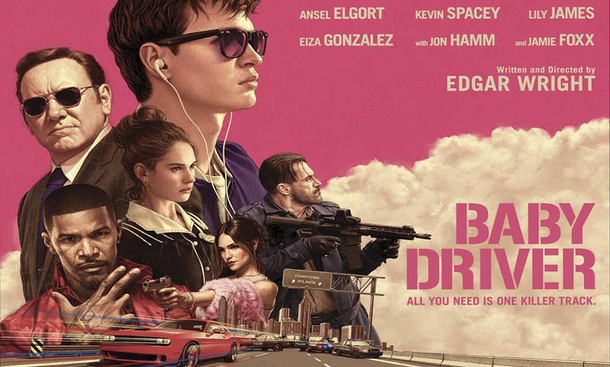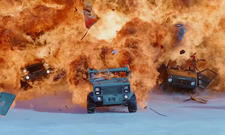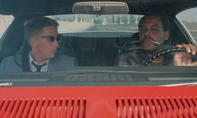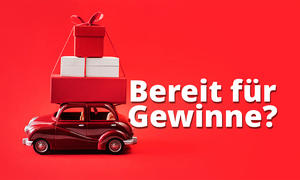Baby Driver (Kinostart: 27. Juli 2017): Trailer & Interview Baby Driver mit Kevin Spacey
Konkurrenz für "Fast and Furious?" Baby Driver (Kinostart: 27. Juli 2017) erzählt die Geschichte eines jungen Fluchtwagenfahrers, der sich in Subaru Impreza WRX und Dodge Challenger SRT Hellcat rasante Verfolgungsjagden liefert. Mit dabei: Kevin Spacey und Jamie Foxx.
Die Hauptrolle in Baby Driver wird von dem noch unbekannten Jungtalent Ansel Elgort übernommen, der in die Rolle des draufgängerischen Jugendlichen "Baby" schlüpft. Der begnadete Autofahrer hat sich einen Namen als Fluchtwagenfahrer machen können und hilft als solcher gelegentlich bei Banküberfällen aus. Da er seit einem Unfall an chronischem Tinnitus leidet, steckt er sich dabei stets Kopfhörerin in die Ohren, um sich mit Musik von dem permanenten Piepton abzulenken. Als er das Mädchen seiner Träume trifft (gespielt von Lily James), sieht Baby endlich die Chance gekommen, seine kriminelle Karriere an den Nagel zu hängen und einen sauberen Ausstieg zu schaffen. Aber nachdem er gezwungen wird, für einen Gangsterboss (Kevin Spacey) zu arbeiten und ein zum Scheitern verurteilter Raubüberfall sein Leben, seine Liebe und seine Freiheit gefährdet, muss er für seine Handlungen geradestehen. Ebenfalls mit von der Partie sind Jamie Foxx, Jon Hamm und Eiza Gonzales. In den USA wurde der rasante Autogangster-Film, der bei uns am 27. Juli 2017 startet, von den Kritikern bereits mit Lob überschüttet.
Trailer Baby Driver:
Trailer: Baby Driver startet am 27. Juli 2017
Neben der tollen Cinematopgraphie, dem auf bekannten Kult-Hits basierenden Soundtrack und der Starbesetzung mit Kevin Spacey und Jamie Foxx, sind es vor allem die vielen großartigen Fahrzeuge, die Baby Driver für Autofans so interessant machen. Wer dem Fokus der letzten Fast-and-Furious-Filme auf übertriebene Action nicht mehr wirklich viel abgewinnen konnte, der kommt jetzt bei Baby Driver voll auf seine Verfolgungsjagd-Kosten. Alleine die Liste der im Film verwendeten Autos kann einem Freudentränen in die Augen treiben: Dodge Challenger SRT Hellcat, Ford Explorer, Nissan Maxima und Subaru Impreza WRX sind nur einige der Fahrzeuge, die hier besonders hervorzuheben wären. Im Interview erzählt der erfahrene Stuntfahrer Jeremy Fry, wie es für ihn war, diese kultigen Autos bei den Dreharbeiten zu fahren an ihre Grenzen zu bringen.
Baby Driver: Interview mit Jeremy Fry
How did your involvement with Baby Driver come about?
Darrin Prescott brought me on. He’s a very in-demand second unit director who’s known for the driving stuff he puts together. He called me up, offered me the job, gave me the dates they’d be filming in Atlanta, and I said, "Yes, of course… Why would I not want to do it?"
What was the main attraction?
Look, just getting to work with a director like Edgar Wright was an amazing opportunity. And then the details of what he wanted to do started to filter through… The basic premise of the story. The kind of gags [stunts] they wanted to do. When I finally saw the script I knew I’d hit the jackpot. What stunt performer in LA doesn’t want to double the lead actor in a movie where the character is a getaway driver and there’s car stuff the whole way through? It doesn’t get any better than that.
How did your work in Baby Driver compare to previous films?
For starters, I got to have a lot more say and was more involved with the development of the different sequences. That happens more often on smaller budget films; not big studio movies like this. So for me, one of the things that was different was that I got to flex my creative muscles. We also had a reasonable amount of prep time. Often times you’re thrown into a movie and you have hardly any time to prep, either because there’s no time in the schedule or because there’s no money. In short, we were able to put together a wish list and have most of those wishes granted. The final thing which set this one apart, though, is that the gags are real and that we got to do them in one take. To a car guy, these shots are really cool. We either haven’t seen them before, or it’s not the kind of thing you see very often. Edgar Wright was agreeable to that. And I think it paid off in the end.
Quick question… Why do you call the stunts "gags"?
Well, you have a sequence, which is the whole thing. Then you have the shots, which are the camera setups…. So if you have a sequence where one guy gets lit up on fire, another guy falls over the railing and someone else gets shot, each of those is a separate "gag". The first guy is doing the fire gag. The second guy is doing the railing-fall and the third guy is doing the bullet hit.
But why is it called a "gag"?
Good question. I don’t know (laughs)…
Did you look at any classic heist films for inspiration when you were prepping?
Not really, though I do look at clips and sequences from old films all the time. For this movie, as we were coming up with ideas, we’d sometimes check out YouTube and try to find clips - dash-cam images from wrecks, that kind of thing. We can then show that to the team and say this is kind of what we want to do.
What cars were used in the film?
We used a whole bunch. But the ones that we used extensively were… Well, the 2006 Hawkeye Subaru WRX. We had at least four of those. We used a Chevy Avalanche – two or three of them - and we used a newer Mercedes, 2014 or 2015, S-550 – we had two of those. We also did some work with the new Dodge Challenger. We had a couple of them. And then one of the characters drives a cop car, so we also had a new Dodge Charger. Those are the ones that we did most of the work with.
What went into the thinking behind those picks?
Well, the idea with the first car, the Subaru, for example, was that we wanted something that would be somewhat innocuous. Nothing that would really stand out – something you’d use in an actual heist. A basic kind of sedan that could blend in. For the sequence that we used the Avalanche, the idea was to go for something bigger and heavier because they know that for that particular heist they might need something with a little more mass than just a sedan.
Did you modify the cars for filming?
All of them had some work done to them. E-brakes, seat belt eyes, that kind of stuff. There was an Avalanche that had a little extra work done to it that makes going up on a wall easier.
And the use of multiple cars?
You have multiples for different reasons - in case you crash one, in case one of them breaks down. Sometimes they’ll want to be mounting lights and cameras on one car, while you’re shooting with the other one. With the Subaru, one them was actually converted to just rear-wheel drive and was putting out some pretty good horse power. We had another one that was built with special aftermarket differentials in the front and the rear, and the motor was worked on a bit. That one was over 300 horsepower and we used it for some of the bigger gags.
What kind of training did you put the actors through?
We spent a lot of time working with Ansel [Elgort]. We also spent a good amount of time with Jon Hamm. But with Ansel… We did some training in Los Angeles before production started at a stunt driving school called The Motion Picture Driving Clinic. We started with the fundamentals and then some specific gags. Darrin Prescott, our second unit director, loves to try and show the actors actually doing something, so it’s not just always the stunt double. So we’ll pick certain gags that we feel the actors can handle and plug them in so they’re actually doing it. Ansel and Jon Hamm both picked it up really fast and we were able to use them for a lot of the stuff.
Just how good was Ansel by the time you wrapped?
I think Ansel thought he was better than he was when he first got there (laughs)… But by the end of it, I think he exceeded his own expectations. He did a really great job. He’s from New York, originally, so he hadn’t driven as much as someone who might have been born elsewhere in the US. But what that meant was he didn’t have a lot of bad habits to break either. So he was a really quick learner. He’s a perfectionist too, like me, which was also great. You know, it takes hundreds of 180s before you can do it without thinking about it. And he did it. He put the work in. He worked hard. And if they do a sequel, I’m sure we’ll be seeing even more of him behind the wheel.
How do you decide when to the let actor do something and when to step in yourself?
There are different factors involved. Sometimes it comes down to something as simple as the actor’s availability. Sometimes they’re shooting another scene and we have to do it. Other times, you look at something and go, "Well he can do it, but you’d never know that that was him." So it’s not worth it to put him in the car. You know, not everything is really hard. A 180 is a 180. It doesn’t matter if I’m driving or Ansel Elgort is driving. But with filmmaking, if you can’t tell, if the car is really far away and you can’t see whose driving, you might as well just have it be the stunt guy.
Did anyone get hurt?
There were a few times when something would break and we’d end up munching the car a little bit. You know, the cars got injured a little bit, but not the drivers.
What was it like filming on the streets of Atlanta?
That was really cool. We filmed all over the city. You know, after we’d been shooting for a while, every time I’d drive into to work, I’d drive by skid marks that I’d left behind earlier. I’d get on the on-ramp and there’s this black skid mark there. I’d then get on the freeway itself and see these gnarly, black skid marks down the number-two lane, where we’d filmed a few days before (laughs)... We literally left our mark on Atlanta.
Edgar Wright has choreographed much of the action within the film to work with a pre-selected 30-song soundtrack. Did that extend to the car sequences as well?
Yes… Trying to create and then choreograph and execute these sequences that would time out with music was really difficult. We tried to come up with stuff that would allow certain things to happen in the shot to roughly time out with the music. But then the biggest problem was just how much time we would actually have or not have in each song. When you come up with these sequences, it’s very easy to go, "Alight, we’ll cover such and such, and from these angles". We would previz everything, shoot it on our own cameras, edit it together, time it out, and then realize we didn’t have time for all the shots. We would then have to distill it down to only the shots that we absolutely needed because of the time limitations. It was a big challenge.
Was that the biggest challenge you faced during production?
Oh man, there’s always challenges. You get through one, and then there’s two more obstacles you’ve got to overcome afterwards. Trying to get certain locations was tough. Trying to come up with new gags that hadn’t been seen before was tough. Trying to make the gags work within the music was tough. And then there’s always the schedule. We had one day in particular with four big setups. And as soon as we got one done, it was all hands on deck – everything is getting loaded up, and we’re caravanning over to the next location. No time for high-fives. No time to bask in the glory of having just got a really cool shot, because we’re onto the next one and we’re running out of daylight.
Is there a particular sequence you’re most proud of?
There’s a handful of really cool shots that are in the trailers - the opening getaway sequence, for example, which features the Subaru. I’m very, very proud to have been involved with that one. All of them I think are really cool, but overall I would say that’s my favorite one, the opening sequence. Within that sequence there’s a few gags that we did that were just really cool.
What kind of a road trip are we ultimately in store for?
The best thing about the car stuff that you’re going to see is that it’s all real. I can’t say there isn’t any CG, because they might put a sun-flare in there somewhere to block my face - that kind of thing. But all the gags you see have not been enhanced to make them possible. None of it is shot on green screen and then put into a real environment. The best part about it is everything you see is what we actually did. And the stuff we did was pretty cool. I’ve never been so proud or excited to see something I’ve worked on up on the screen. At the risk of jinxing it, I think this is going to be one of those movies that people will look back on and say, "That was really something else".

 1. Klicke neben der Adresszeile rechts auf das Ad-Blocker-Symbol.
1. Klicke neben der Adresszeile rechts auf das Ad-Blocker-Symbol.
 2. Wähle die Option "Deaktivieren auf: www.autozeitung.de".
2. Wähle die Option "Deaktivieren auf: www.autozeitung.de".

















